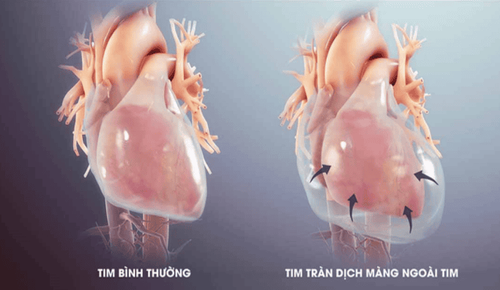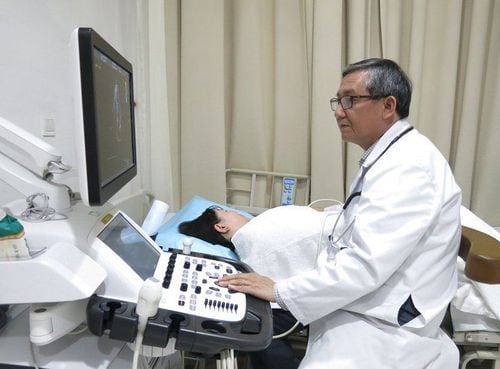This is an automatically translated article.
Pericardial effusion has many different degrees, with a large amount of pericardial fluid will cause cardiac tamponade. Cardiac tamponade is a medical emergency that requires early diagnosis and treatment to ensure circulatory function. Echocardiography is an imaging method that allows accurate diagnosis of pericardial effusion and especially cases of cardiac tamponade.
1. Overview of pericardial effusion The pericardium acts as a protective barrier, promoting more efficient cardiac activity and preventing excessive movement of the heart. The pericardium consists of 2 layers, normally between these two layers there is a small amount of fluid created by the sac-like structure that surrounds the heart, to help the heart function normally.
However, when the amount of fluid between the two pericardium increases abnormally, it is called a pericardial effusion. Fluid accumulation in the pericardium can be blood, pus, permeable fluid or exudate from a variety of causes including:
Infection: Microorganisms can cause pericarditis and lead to overflow pericardial fluid. Some microorganisms that can cause disease include tuberculosis, pneumococcal, staphylococci, syphilis, HI; viruses such as EBV rubella HIV and fungi. Diseases related to autoimmune factors such as: systemic lupus erythematosus, rheumatoid arthritis, scleroderma, ankylosing spondylitis... Rheumatic heart disease: Appears after infection with group beta-hemolytic streptococcus bacteria A for a while. After some drug treatment or after surgery, chest procedures, using radiation. Heart problems: myocardial infarction, thoracic aortic aneurysm, and effusion can be seen during chest pain. Cancer: Cancer metastases to the pericardium can be seen in cancers such as breast cancer, lung cancer, leukaemic malignancies... Kidney failure: When blood urea levels are too high May cause pericarditis and pericardial effusion. Trauma: Caused by direct damage to the heart is quite rare. But penetrating chest trauma, esophageal perforation, foreign body, mediastinal radiation are the causes of pericardial hemothorax. Pericardial effusion, if at a small level, can cause unknown manifestations. But if it is severe, the patient often feels chest pain, shortness of breath, cough, nervousness, palpitations, if more severe, the patient may faint due to lack of blood supply to the body.
Pericardial effusion is a dangerous condition because the larger the amount of fluid, the more compression of the heart. When the amount of fluid increases, it will make the heart less able to hold blood, thereby unable to ensure the function of bringing blood to the organs in the body, causing lack of oxygen and thereby causing dangerous complications. Cardiac tamponade is an emergency and needs to be diagnosed and treated promptly, because it can be life-threatening.

Tràn dịch màng ngoài tim có nhiều mức độ khác nhau
2. Diagnosing pericardial effusion by echocardiography Currently, there are many methods to help diagnose pericardial effusion such as X-ray, chest computed tomography, magnetic resonance imaging (MRI)... However, the first-line method used to diagnose and evaluate primary pericardial effusion is echocardiography.
Echocardiography is a method that uses a transducer with a frequency of about 3.5 MHz to 5 MHz passed through the body and then captures normal and abnormal images of the heart. Echocardiography in the diagnosis of pericardial effusion has the following advantages:
This is a non-invasive method for fast, accurate and affordable diagnosis. Echocardiography has high sensitivity and specificity. The image of pericardial effusion on echocardiography helps to estimate the degree of fluid. Sometimes, based on the echogenic characteristics of the fluid structure, it helps to identify different types of fluid such as blood, pus, and other fluids. Helps assess the response of the heart to excess fluid in the pericardial cavity. That is to measure the parameters of the heart's activity, see the level of activity when compressed and when it is normal to take appropriate treatment measures.

Siêu âm tim trong chẩn đoán bệnh tràn dịch màng ngoài tim có nhiều ưu điểm
With reasonable cost and relatively simple method, this is also the most effective method to monitor response progress during treatment. Especially in the case of dangerous acute cardiac tamponade, patients with indications for emergency pericardial drainage, echocardiography to help guide the location of puncture, minimize the risk of complications due to cardiac arrest. tips. Echocardiography may be more limited in cases of very low volume. For small cases of pericardial effusion, it is necessary to combine with computed tomography or magnetic resonance imaging.
In general, echocardiographic pericardial effusion is an indispensable method, especially in cases of suspected acute cardiac tamponade. Echocardiography not only helps to make an accurate diagnosis but also helps to monitor the treatment of pericardial effusion. However, for echocardiography to achieve the desired effect, it is necessary to have a high-resolution ultrasound machine, which gives better images and helps in accurate diagnosis. In addition, echocardiography is a technique that requires the operator to have experience, sensitivity and appropriate expertise to limit missing lesions.
With many years of experience in the examination and treatment of cardiovascular diseases, now Vinmec International General Hospital has become one of the major Cardiology centers, possessing a team of qualified doctors and nurses. , be trained. In addition, for early diagnosis of pericardial effusion, as well as many other cardiovascular diseases, Vinmec is also equipped with state-of-the-art diagnostic equipment and facilities such as 2D, 3D echocardiogram machines with full features Transesophageal and chest wall ultrasound, electrocardiogram, Holter blood pressure machine, Holter electrocardiogram machine, stress ECG machine: Running mat, tilt bike, tilt test...
Especially, at Vinmec also has a Hybrid Operating Room with state-of-the-art equipment such as DSA angiography machine, integrated anesthesia machine that brings the highest efficiency in the treatment of cardiovascular diseases with the most modern minimally invasive techniques. Therefore, with the diagnosis of pericardial effusion as well as other diseases, it will be detected and treated promptly, avoiding potentially dangerous complications.
Please dial HOTLINE for more information or register for an appointment HERE. Download MyVinmec app to make appointments faster and to manage your bookings easily.













